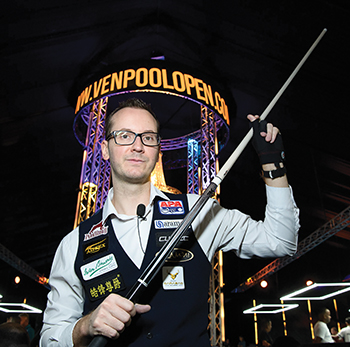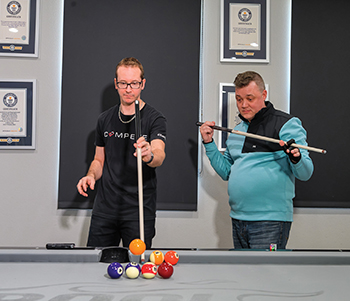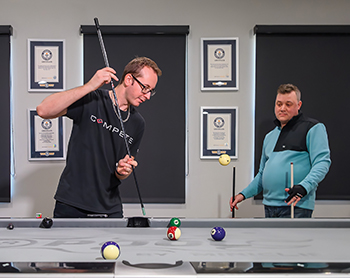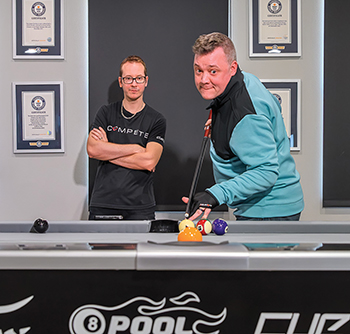


 |
 |
 |
| HomeAbout Billiards DigestContact UsArchiveAll About PoolEquipmentOur AdvertisersLinks |
|
Browse Features
Tips & InstructionAsk Jeanette Lee Blogs/Columns Stroke of Genius 30 Over 30 Untold Stories Pool on TV Event Calendar Power Index |
Current Issue
Learning to Fly Eager to add pool's most entertaining shot to his arsenal, the author consults the sport's resident artistic genius.
By Keith Paradise Photos by Erwin Dionisio When it comes to the topic of jump shots, there are few people in pool with more experience with its execution than Florian Kohler. The 36-year-old has won 16 trick shot competitions in his career and earned his first World Pool Association's World Artistic Pool Championship in February. He holds Guiness world records for the highest and longest jump shots and was the fastest to execute 15 jump shots. This talent has tied him with Mike Massey for most World Artistic Pool discipline medals with 13 while also making him the most-downloaded trick shot artist in history, with approximately a billion views worldwide on various platforms. These short films, which show him aggressively rifling jump shot after jump shot in some sequences, has earned him over a million subscribers on his YouTube channel which has over 246 million views. Kohler was interviewed in May about the history, and evolution of the jump cue and, when subject briefly veered into the reporter's jumping abilities, I suggested that buying stock in a company that manufactures VCRs might be a more solid investment than handing me a jump stick. I was convinced part of this lack of ability came from a mental block installed by my grandfather, hardly a world class player but one who had stern rules for the eight-foot Fischer table in his basement — especially if my grade school-aged self dropped the balls onto the table.  “Don't bounce the balls on the table,” he'd bark. “You'll damage the cloth.” When I told Kohler that the instruction has caused a conflict within my brain ever since whenever I have a jump cue in my hand, he had a quick solution. “If you ever come to Vegas, let me know,” he said. “I could teach you to jump in five minutes,” Challenge accepted. When work brought me back to the desert for February's Rums of Puerto Rico Las Vegas Opens, I took Kohler up on his offer and spent an afternoon at his home learning the methods that he used to win back-to-back World Cups of Trick Shots. Contrary to his proclamation, he did not have me jumping the ball in five minutes — it was closer to three. “I think the jump shot is pretty easy,” he said. “I think a stroke shot is much more difficult to learn than a jump shot. I could set up a crazy stroke shot that I guarantee that 99-percent of players wouldn't be able to do.” Tucked at the base of the foothills about 30 minutes from the Strip, the Kohler home contains an impressive four pool tables — including a full-sized Diamond in the dining room and an outdoor dining table which converts for pool on the backyard patio. The tables almost distract from the impressive number of trophies, plaques and awards throughout. Our lesson took place in the second story loft on a full-sized Rasson, one of two installed in Kohler's work area. He recently installed decorative tile on the one far wall because so many mishit shots had turned the drywall underneath into something that looked like the surface of the moon. Originally from France, he began playing the game when his parents purchased a small recreational table for him when he was about 17 years old and was almost immediately drawn to trick shots after discovering videos of players like Mike Massey, Paul Gerni and “Dr. Cue” Tom Rossman. Like many young and inexperienced players who attempt jump shots, he learned to “scoop” the ball by jamming the tip under the cue ball which forced it upwards like a sand wedge going underneath a golf ball — a technique he became pretty good at in his early days. He could easily clear three feet in height with the scoop method and some of Kohler's early trick shot videos, nearly two decades old and still available on YouTube, show him successfully using this technique. There was just one major issue: This method isn't legal. When he tried learning how to correctly strike the shot, he suffered a similar fate as many beginners: failing to secure even a millimeter of elevation. “I remember being pissed off that I couldn't get any air,” he said. “It's a weird illogical thing to jump a ball. I never had a teacher for jumping or anything like that. I just had to figure it out. I think it took me a good year to learn how to legally jump a ball.” When Kohler, who possesses a college degree and is a certified optician, eventually realized the physics behind the shot — that the hardness of the cue's tip builds pressure when it strikes the ball, which transfers to the slate and exits through the ball jumping — the strategy behind the shot became easier for him to understand and ultimately execute. As cue and tip technology continued to evolve — first with the creation of devoted jump cues and then harder tips like the phenolic and fiberglass G10 — jumping successfully became exponentially easier. In fact, one of Kohler's many videos display him jumping a ball by simply throwing the cue stick at the ball. One of the common misconceptions that Kohler, who is an American Poolplayers Association league operator as well, frequently hears is that a player who can't break hard also won't be able to jump. He disagrees, adding that the shot is more about the quickness of the stroke rather than the power behind it. He recalled bringing a married couple from his league over to the house for a jumping lesson a couple of years ago, with the husband sporting a Fargo rating of around 650 and his wife just starting in the game and carrying a number two-hundred points lower. In the beginning of the session, the wife picked up on the technique quicker since she didn't have as much ingrained muscle memory to overcome. “He wasn't happy at first, but he caught up,” said Kohler. “He also scrapped his jump cue and got a new one.” The “Anti-Shot” The lesson starts with the world champion lining up three balls on the long rail near the side pocket, then setting up a similar line of three balls about a diamond-and-a-half away in the center of the table. The object of this drill is to shoot the balls pinned to the rail over the blocking balls and into the opposite side pocket. Where the ball meets the rail aligns almost exactly with where the cue tip should be striking the ball in order to execute the shot successfully — and also eliminates any opportunity to slip under the shot and “scoop” the ball. Not only does this rail shot expose the exact sweet spot where the ball should be struck but being pinned forces the shooter to elevate their bridge, building in an additional angle to help with securing the correct striking point. The butt of the cue should be at about a 45-degree angle in order to be successful. “So, basically the jump shot to me is the anti-pool shot,” he said. “Whatever you know from normal pool, which is a long, steady follow through, this is basically the reverse. It's a short, fast poke with a short motion rather than a long motion.” When I pushed my first attempt directly into the row of balls in the middle of the table, it was equal parts frustrating but also vindicating, as if I was showing evidence that I truly am terrible at this. “That was too slow and too much of a follow-through,” he said. “Shorter, faster and more elevation.” I quickened the pace — attempting to make a fast punch — and the next attempt got airborne but struck the top of the blocking balls. We had lift off on the third attempt, as the ball successfully cleared the obstacles but missed the side pocket, rolling back across the table thanks to a bit of left-handed sidespin. It was a start at least.  Kohler showed the ease of the Dart Method by shooting one-handed (and with his left hand). The Dart Method Having established where and how to hit the cue ball, Kohler experimented with changing how I held the cue, replacing the traditional underhanded technique using three fingers to hold the handle of the jump cue like a dart about to be tossed, known naturally as the “dart method.” Although professional players and top amateurs are looking to pocket the object ball on a jump shot (or if you're Fedor Gorst, pocket the ball and land position on the next shot), average and recreational competitors are normally simply trying to contact the ball to avoid a foul. With a motion that mimics throwing a dart towards a dart board on the table, Kohler believes this technique is an easier way to accomplish the task. The method can result in a sacrifice of accuracy but that is offset by a wrist motion that for many is quicker than the underhanded delivery of the traditional stroke. “Because you're doing dart style your wrist is going to make the action go quicker,” he said. “A short, fast poking motion is important.” I struggled with the first couple of attempts thanks to shooting the shot a bit too slowly, then popped three straight shots over the blocking balls but still was missing to the left of the side pocket. By now, the sound of the hit was also sounding more crisp, rather than the laborious clunk that contact was in the beginning. After finally finding the correct spot to grip the cue using the dart method, holding it closer to the balance point near the joint, Kohler upped the ante and moved the blocker balls closer to the cue balls by about a half diamond. He now had me elevate the butt of the cue more and instructed me not to use all of the 14-millimeter tip to strike the ball, instead using only the top half. “You're going to go a little more vertical and a little more back of the ball,” he said. “You're at the same spot but a little less tip contact.” Easier said than done. After flubbing the first five attempts, I finally cleared the balls on sixth try but again missed the pocket to the left, which also happened on my eighth and ninth shots as well. “Use your problems to your advantage,” he said. “If you know you're going to miss left, aim further to the right.” It was about this time that I recognized that I was so focused on getting the shots airborne that I'd neglected to notice that my body was pointed to the left. With everything mostly properly aligned I still aimed a bit further right and jumped three consecutive shots into the side pocket. Mission accomplished — or so I had thought.  Getting “air” is hardly a problem for Kohler, who incorporates jump shots in much of his artistic pool repertoire. Getting the “Full” Experience Now that the task of consistently clearing obstructing balls had been completed, the next goal was to actually, you know, attempt to pocket a ball. In a training session that had already included so many instructions that send the thought process sideways — use a short poke instead of a long stroke, punch quick instead of powerfully — here came another one. He set an 8 ball beyond the blocking balls, slightly off angle from the side pocket. “Go full into the ball and it cuts naturally,” he said. “Don't even aim for the pocket. Go straight into the eight.” Excuse me? Kohler explained the physics behind the execution. When cutting a ball normally, the cue and object balls collide on the same equator and this, coupled with the friction of the cloth, allows the ball to travel on the correct plane into the pocket. However, when the cue ball instead collides with the object ball while airborne, its equator is higher, making the point of contact higher and changing the angle of the cut — with many shots being overcut as a result. The way to correct the direction is to try and land on the ball more fully. As my mind tried to grasp this concept, I continued to try and cut the ball into the side pocket in my first four attempts and, naturally, overcut the shot. “You don't trust it,” he said. “Your brain is making the adjustment.” He was right, of course. The directions felt similar to driver's education class when the teacher said the way to straighten out a vehicle that was skidding on ice was to turn into the direction of the skid. Finally, on the fifth attempt, I aimed for a full-on hit on the ball, struck it dead on and watched it disappear into the side pocket.  By day';s end, the author had earned his wings. “And now, for my final act...” By this point, I had become relatively proficient using the long rail as a pair of training wheels so naturally the teacher removed them completely at the end of the lesson. Kohler set up the cue ball about a diamond behind the spot then placed the blocker balls near the spot to work on table length jump shots from the middle of the table. Now, I'll need to find the correct spot on the ball from memory. At first, the task is again simply to clear the balls without the assistance of the rail, which was a struggle in the first couple of attempts as I fumbled around with my bridge hand trying to find the most suitable setup. Thanks to repetition along with focusing on delivering short, quick bursts, the shots became more active and accurate, clearing the cluster and heading down table. The advantage to these longer shots, Kohler said, is that it feels more like a more normal pool shot — to the point that it is sometimes more beneficial to use a break cue for execution. For shots where the obstructing ball is a diamond or less away, a jump cue is recommended but for longer distances, such as the one I was now facing that involved the 3 ball at the opposite end of the table near the corner pocket, the full-length cue has its advantages. For this shot, I was handed the break cue. The bulkiness of a full-sized cue after using the smaller stick all hour initially threw me off. I mishit the first attempt but cleared the defensive balls on the next try. On the third attempt, I cleared the defensive cluster, hit the 3 ball flush and sent it directly into the corner pocket. “Pretty good,” Kohler said. In a span of 45 minutes, I had gone from failing to get the cue ball airborne altogether to landing table-length shots — proving that the teacher's assessment of his ability to teach the technique was accurate. “I would say I still have yet to find someone to this day that I can not teach using the on-the-rail method,” he said when the lesson was over. Tips for “Venomous” Jumping - It's the “anti-shot,” according to Kohler. Instead of a long, slow and fluid stroke, you're looking to use a quick, short hit on the cue ball. - It is not about how powerfully you strike the shot, but how quickly. - With the latest in jump cue and hardened tip technology, almost anyone can jump a ball. - The “dart” technique — holding the cue butt with three fingers like a dart — can result in that short, quickened delivery needed. - When a cut shot is involved, aim to hit the ball object full and the shot will cut naturally on impact. - Use your issues to your advantage. For example, if you're a player who misses to the left frequently, aim more to the right.
|
|
Since 1978, Billiards Digest magazine has been the pool world’s best source for news, tournament coverage, player profiles, bold editorials, and advice on how to play pool. Our instructors include superstars Nick Varner and Jeanette Lee. Every issue features the pool accessories and equipment you love — pool cues, pool tables, instruction aids and more. Columnists Mike Shamos and R.A. Dyer examine legends like Willie Mosconi and Minnesota Fats, and dig deep into the histories of pool games like 8-ball, 9-ball and straight pool.
Copyright © 1997 - 2025 Billiards Digest
All Rights Reserved
Luby Publishing, Inc.
310 Busse Highway PBM #319 | Park Ridge, IL 60068
Phone: 312-341-1110 | Fax: 312-341-1469